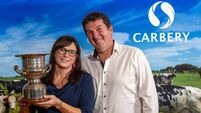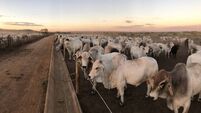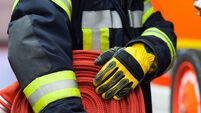What a week we have had, so far.
Ground conditions have deteriorated significantly due to the rain since last week, even before the orange, yellow and red weather warnings.
Cattle are starting to damage ground and to walk grass into the ground.
Grazing strategies in these conditions will determine animal performance and also how much more grass you will get to graze for the remainder of the year.
You must protect the ground by using strip wires, back fencing, and giving stock 12-hour allocations, or less if conditions get very poor.
Pick your driest paddocks over the next few days, and graze lower covers, so less grass is walked into the ground.
Stock need moving more often.
Hopefully this spell will not last too long, as there is lots of grass out there, due to excellent growth recently.
The harvest is also at a standstill, they could really do with a window to get spring crops combined and straw saved.
Autumn suckler heifer management
As we get closer to housing, it is always a good time to assess animal performance.
A replacement heifer strategy is an important part of suckler farm management. These animals are the future of the herd, and good heifer rearing or sourcing provides a sound basis for a profitable business.
A successful heifer rearing strategy sets defined targets and ensures these are achieved, through regular monitoring of the animals throughout the rearing period. The aim is to raise an animal that, once calved, can maximise her genetic potential for production.
Central to the cost of production is the chosen age for calving.
For sucklers, the accepted optimal target is generally 22-24 months. Under this age, there will be an increased incidence of calving difficulties and reduced productivity after calving.
Heifers that calve late may become over fat before calving, and rearing costs are increased. However, if a farm is unable to achieve target weight gains required to calve at 24 months, it is better to calve later and accept increased rearing costs, than to calve small, unproductive animals.
Current heifer status
At this time of year, there are generally four types of heifers on most suckler farms: suckling their mothers, heifers weaned that will be put in calf for next autumn, heifers for finishing off grass or indoors, and those in calf for next spring.
Heifer targets
Heifer rearing can be expensive, with up to 60% of the costs being incurred in the first nine months while with their mothers.
Understandably, there is often the temptation to try to find feeding and management systems that reduce rearing costs.
However, it is no good saving feed costs for a calf if it later results in increased mortality, increased time to service, and smaller heifers at calving. Ensuring that target growth rate is met during this period is important to maximise the future fertility and productivity of the animal.
The target growth rate for heifers varies according to age, and is influenced by the planned age and weight at calving, and also by their breed.
The aim should always be to achieve a well grown heifer at calving; obviously, the better grown the heifer is at calving, the less growing she needs to do in her first and second lactation, so the more energy she can divert into milk that she can produce for rearing her calf.
There is a fine line between achieving target weights at calving and falling short.
For example, if your target is to have a heifer at 600kg for calving at 24 months: with a birth weight of 40kg, she must gain an average of 0.77kg/day over the 730 days (two years). Achieving an average of 0.7kg/day, you will only have a 551kg heifer at first calving. It may seem a small difference per day, but it amounts to a lot over two years.
The right type of growth in heifers
Growth in heifers should be directed towards muscle tissue growth, not fat cover.
This can be most influenced by providing suitable levels of protein and avoiding diets with high starch and low protein content in the coming winter.
Digestible fibre and protein are the essential nutrients required for efficient frame growth.
High starch diets in heifers will result in excessive fat deposition in the udder, reducing mammary tissue development and subsequent milk production.
So, given the above requirements for growth, it is critical that there are no prolonged periods of very low growth in replacement heifers. Heifers that have been inseminated to calf next spring need to be provided with sufficient good quality grass to maintain good growth.
If these heifers are on poor quality grass, have low intakes due to the current wet spell, or are tight on grass, they will need to be supplemented with concentrates.
If suckler cows with calves at foot are on restricted pasture quantity or quality, then creep feeding should be introduced to keep calves growing pre-weaning, and to comply with BEEP-S requirements.
Buying in replacements
Many suckler farmers will look to buy in replacements rather than breed their own.
It is important to know what you want in a heifer before you go out buying.
One thing that is worth remembering is to aim for milk in the cow and meat in the bull, in the suckler herd.
A narrow heifer will be harder to calve and will leave you with a poor quality weanling, store, or finished animal.










